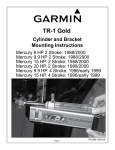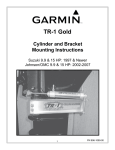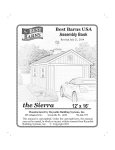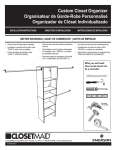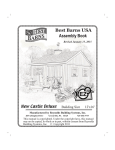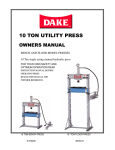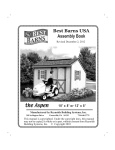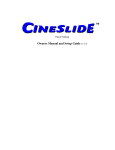Download Garmin TR-1 Instruction Manual
Transcript
TR-1 Gold Cylinder and Bracket Mounting Instructions Honda 9.9 HP : 1987-2000 Honda 15 HP: 1987-2002 Page 1 PN 906-1050-00 Parts: Cylinder Mounting Kit PN 120-1050-00 8 3 1 2 11 9 5 12 13 4 Figure 1 ITEM 1 2 3 4 5 8 9 11 12 13 PART NUMBER 330-1051-00 130-1052-00 330-1003-00 380-1054-00 380-1056-00 310-0206-12 130-0083-00 310-2501-25 310-0067-01 310-0067-02 QTY 1 1 1 1 1 3 1 1 1 1 Page 2 DESCRIPTION NUT, STANDOFF BRACKET, ROD EYE MOUNTING PIN, STERN PIVOT CHANNEL, CYLINDER MOUNTING PLATE, STANDOFF NUT HEX CAP M6 X 12MM HOSE CLAMP CLEVIS PIN HAIR PIN, COTTER, LARGE HAIR PIN, COTTER, MEDIUM Cylinder Kit PN 120-0900-00 35 38 40 34 Figure 2 31 33 34 35 36 330-1002-00 310-0042-09 340-0900-00 321-0001-00 330-1101-00 Rod Eye, 5/16-24 Hex Jam Nut 5/16-24 Cylinder Fitting, Straight 1/8 NPT X 1/4 Zinc Anode (Replace) 1 1 1 2 1 37 38 40 310-0040-26 328-0901-00 328-0902-00 Washer, Flat, Nylon 1/4 ID X .03 Bushing 1/4 ID X 5/16 OD X 1/4”L Cylinder Tail Bushing 1 2 1 Tools Required Section 1. Installing the Cylinder Mounts. Tools Required: 9/32 inch or 7mm wrench 10 mm wrench 1/2 Inch wrench (at least one needs to be open end) Thread Lock (Loctite or similar) Figure 3 Page 3 Step 1: Rear Nuts Tip the motor all the way up. Remove the two rear nuts from the lower motor port side vibration isolation mounting shroud by loosening the screws that come in to them from the starboard side. Leave the screws in place. Figure 4 Step 2: Nut Plate Put a little thread lock on the protruding ends of the screws just loosened. Thread the screws into non flat side of the Standoff nut plate (item 5) as shown in figure 5 and tighten them. Figure 5 Page 4 Step 3: Front Screw Remove the forward nut from the lower motor port side vibration isolation mounting shroud by loosening the screw that comes into it from the starboard side. Again, leave the screws in place. Figure 6 Step 4: Standoff Nut Again, put a little thread lock on the protruding end of the screw just loosened. Thread one end of the standoff nut (item 1) on to the screw as shown in figure 7 and tighten it. Figure 7 Page 5 Step 5: Mounting the Channel Put a little thread lock on the ends of the three 6 mm Hex Cap screws (item 11) and install them through the cylinder mounting channel assembly (item 4) and into the standoff nut and standoff nut plate (items 1 & 5). (Channel with the label facing you right side up.) Keep the channel perpendicular to the motor down shaft and tighten the nuts. Figure 8 Step 6: Align Mounting Bracket Slide the bend on the top of the Rod Eye Mounting Bracket (item 2) under the tube on the inside of gussets on the motor’s steering pivot bracket as shown in figure 9. Figure 9 Step 7: Hose Clamp Open the hose clamp (item 9) and install it around the shank of the motors’s steering pivot bracket and over the tab on the bottom of the Rod Eye mounting bracket (item 2). With all in place firmly tighten the hose clamp. (Be sure the hose clamp screw does not interfere with the steering rotation when the motor is turned to steer it.) Loosen the steering tension device to the minimum setting. (Refer to your outboard owners manual.) Figure 10 Page 6 Step 8: Cylinder Rod Eye Place the Rod Eye (item 31) over the vertical pin in the rod eye mounting bracket (item 2) as shown. (Leave the cylinder attached.) Install the Medium hair pin cotter (item 13) through the hole in the vertical pin. Turn the cylinder (item 34) fittings (item 35) up. Figure 12 Step 9: Cylinder End Cap Line the hole in rear end cap of the cylinder (item 34) with the hole in the top of the stern pivot pin (item 3). Slide the Clevis pin (item 11) through the hole into the stern pivot pin. Put the Large Hair Pin cotter (item 12) through the cross holes in both pins. (Under the channel flange). Figure 13 Page 7 Step 10: Full Port and Starboard Turn the motor hard over to port. That will retract the cylinder rod into the cylinder. Check that the cylinder rod is still free to retract at least a little more. Next turn the motor hard over to starboard. That will extend the cylinder rod out of the cylinder. Check that the cylinder rod is still free to extend at least a little more. It should have additional travel in both directions. If it does not adjust the position of the Rod Eye (item 31) on the cylinder shaft. The cylinder shaft should turn with your fingers if the Hex Jam Nut (item 33) is loose. (If the shaft does not turn freely enough, use a thin 1/4 Inch open end wrench at the shaft’s wrench flats.) Do not use Figure 14 any tool on the cylindrical part of the cylinder shaft. If the shaft gets scratched or bent the seal will fail. With the cylinder properly adjusted, secure it by tightening the Hex Jam Nut against the Rod Eye. (Use Thread locking compound on the rod eye block threads and the Jam Nut.) It is ready for plumbing. We suggest you put the original parts in a container and, carefully, store them. (You may eventually want to sell or trade in your motor; but we know you will want to keep your TR-1 Autopilot Figure 15 Page 8








